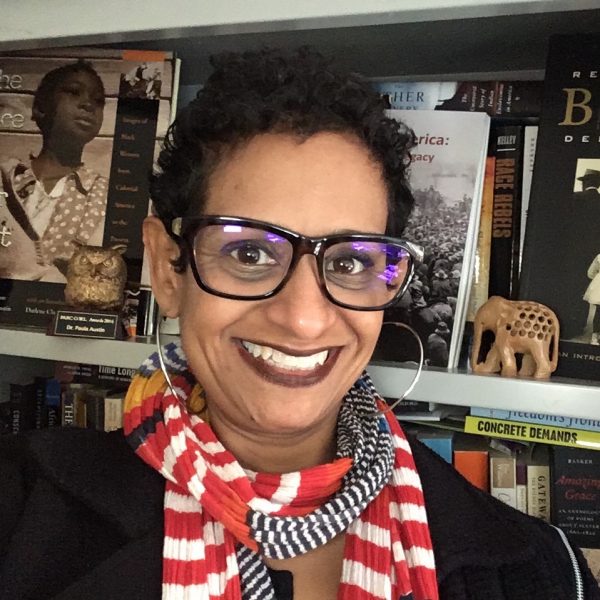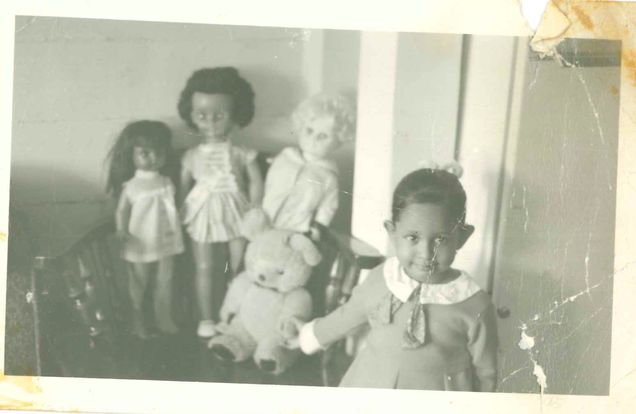BU Historian Asks Why Black Youth Cannot Not Be Intellectuals
This article by Mandile MPofu (COM ’24) was originally published in the Arts X Sciences Magazine on April 8, 2024.

As an undergraduate, Paula Austin wrote stories about the day-to-day life of a 20-something Black girl in New York City named Alice. A literary reflection of Austin, Alice mostly did nothing. She woke up in the morning, brushed her teeth, rode the subway, walked around, bought groceries, and chatted with people in her apartment. Sometimes a conversation went awry. Other times, tragedy struck. But usually, Alice just went about her daily life—the quotidian.
Austin, then a creative writing major, was intrigued by the lives of ordinary people like Alice, by what she calls the “slowness of mundane life.” Her interest inspired her to go on to graduate school in African American history, where she could delve deeper into the untold stories of marginalized people like Alice.

“Marginalized people are not really visible in the record as individuals or as communities,” says Austin, now an associate professor of history and African American and Black diaspora studies. “We know about them as an aggregate. But who are these individuals, and what are they doing? What does it look like?”
While working on her PhD, Austin found interviews of Black teenagers living in 1930s Washington, D.C. in E. Franklin Frazier’s papers at Howard University’s Moorland Spingarn Research Center. The teens shared their experiences of being young, poor, and Black within the confines of Jim Crow laws. As Austin examined the archival materials, she asked herself why the young people’s ideas—their mundane lives—couldn’t be considered “intellectual history?”
Intellectual history is defined as the study of the individuals who conceive, discuss, and publish ideas, and, “in the field of history, the subfield of intellectual history has had a very narrow definition,” she says. “It comes out of a tradition that then becomes a protocol, a practice, a method, a rule as the field becomes professionalized that defines ‘”intellectuals’” as generally white cisgender heterosexual elite men who left written records of their thoughts and ideas and who were often in positions of power.”
Why couldn’t Black youth be intellectuals? They had ideas and thoughts about their identities, she noticed, and they were influencing their families and communities. Since then, Austin has continued to expand the scope of intellectual history by redefining “intellectual” to include marginalized people living “mundane” lives.
Teaching history
Austin knew from a young age that she wanted to teach. There is a photo of her when she was about three years old, sitting in her room in Georgetown, Guyana in her nursery school uniform. In front of her, there are rows and rows of dolls lined up as though they were in a classroom. She is the teacher.

As a toddler, Austin’s family moved to Brooklyn, where her mother worked as a live-in home aide, one of the jobs available to Caribbean Black women at the time. In college, Austin minored in education, along with creative writing. After graduation, she worked in adult literacy, and now, as an academic, Austin continues to prioritize her teaching even as she continues her own research. She says her three-year-old self would be “glad that I was still teaching because clearly, she thought that was what one should do.”
As a young person, no matter what career she chose, she felt the most important thing she could do was to make an impact, no matter how she did it. Influenced by the lessons of bell hooks, Paulo Freire, and other radical educators from the 1980s and 1990s, Austin’s philosophy as a teacher is that she has little say in what her students do with what she teaches them—her only job is to help them be impactful once they leave her classroom. The tiniest shift is what she aims for.
Within the last year or two, a handful of states—Arkansas, North Dakota, Mississippi, Texas, to name a few—have passed laws banning lessons on parts of African American history. Even before the onset of the bans, Austin says there were first-year and second-year undergraduate students who entered her classrooms and said they had never learned Black history. For those who had, they were taught the bare minimum. Austin says she is not certain what effect the history bans will have “given that I’m not sure the curriculum at the elementary level even looked like anything that had anything to ban in it.” What she does know is that elementary and middle schools must teach history.
“All of my teaching and research experience confirms that we, as a society, need history. Frederick Douglass talked about the importance of a ‘usable past,’ and I take my job as a history educator and writer very seriously,” she says. “There are so many lessons in our history that can help us grapple for a more just society today.”
Expanding History

As a researcher, Austin continues to build on the work of other scholars to ensure that intellectual history is more inclusive of individuals and communities who have previously been overlooked. Expanding who we think of as intellectuals and how we think about intellectualism, she says, is an important intervention in her field, especially in the study of all marginalized peoples because it helps us more accurately and clearly understand our history and our contemporary moment.
In 2019, Austin published Coming of Age in Jim Crow DC: Navigating the Politics of Everyday Life, an intellectual history based on the archival materials she had studied during graduate school. The work presents the everyday lives of poor and working-class young Black people, portraying them as “thinkers, theorists, critics, and commentators” as they confront segregation-imposed restrictions and racial violence.
Since the publication of her book, Austin has returned to the archives to dig up other facets of Black history that have traditionally been excluded from the mainstream, specifically histories that took place in Washington, DC. She has written about the Black women—mothers, aunts, sisters—living in the Jim Crow era and their experiences with bodily autonomy. She has also explored the history of leisure and recreation in Black communities before the passage of the Civil Rights Act, focusing on the Par-Links Golf Club, an association of Black women golfers founded in 1958 in East Bay, Oakland California, and its role within the local and national fights to desegregate public golf courses and professional golf in US history.
In the wake of protests after the murder of George Floyd in 2020, she wrote about Black youth activism and police violence in DC, the subject of her next book project. Austin has been collecting newspaper articles published from 1920–1970 to craft a history of the movement against police violence in Washington, DC, including a look into coalition building and activist organizing.
Although she does not consider herself an activist, Austin says she sees herself in the people she writes about, those who identify as activists and those who don’t but are “making activist decisions” for their communities. This is what drives her research—a hunger to peel back the layers on and spotlight “regular” Black individuals whose everyday choices, like hers, influenced their communities.
“The people that we’re writing about are expressing themselves, and they are confident in these expressions. It’s just that the field of history has not taken those expressions seriously,” she says. “I feel like I’m making an impact on my little small world. And I think that that’s true for everybody. We’re making impacts on our little small world, and we matter. So I want to write our stories.”